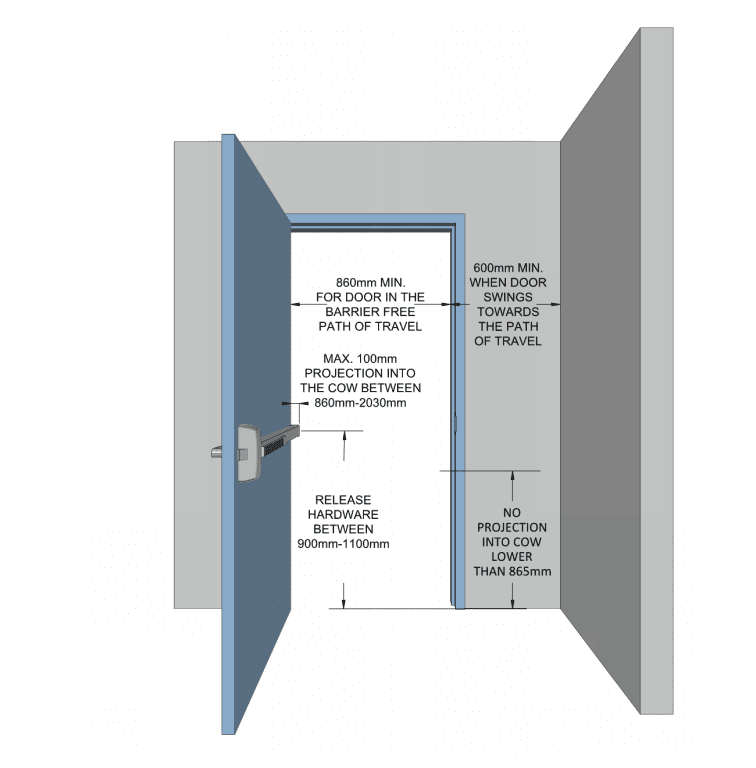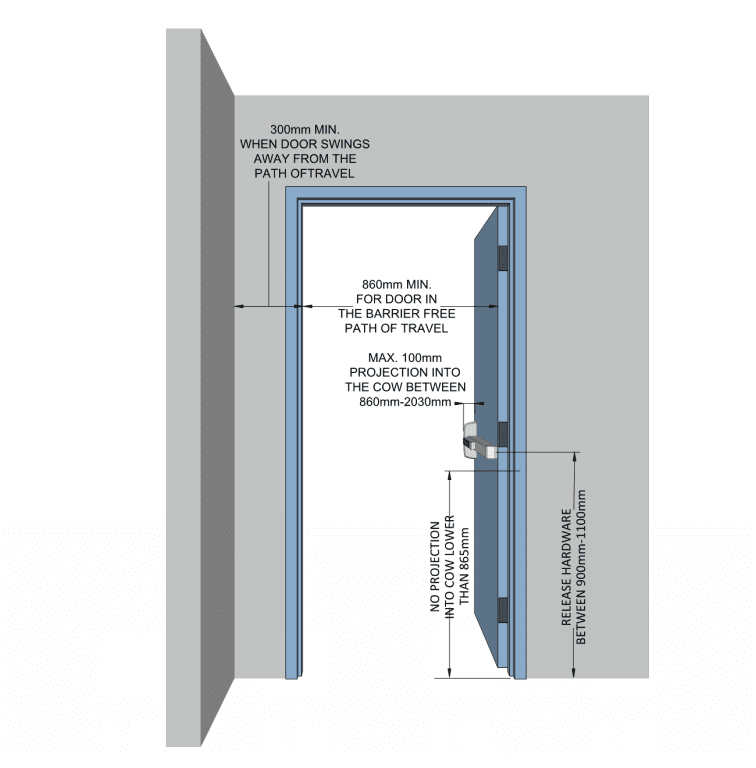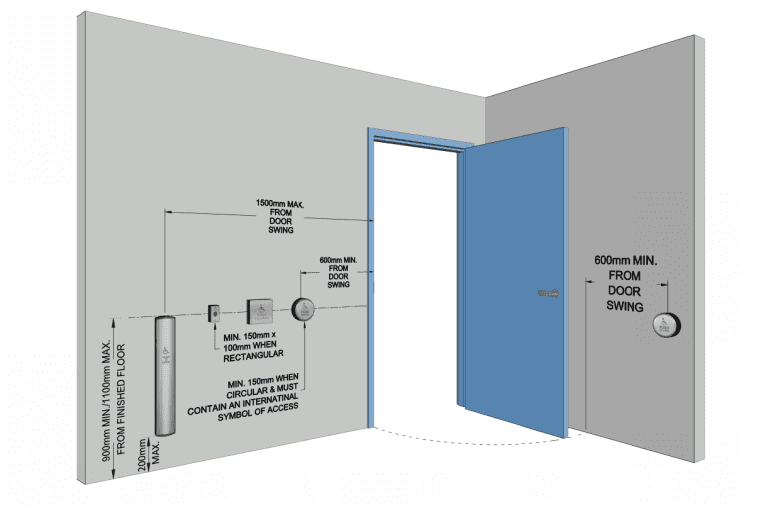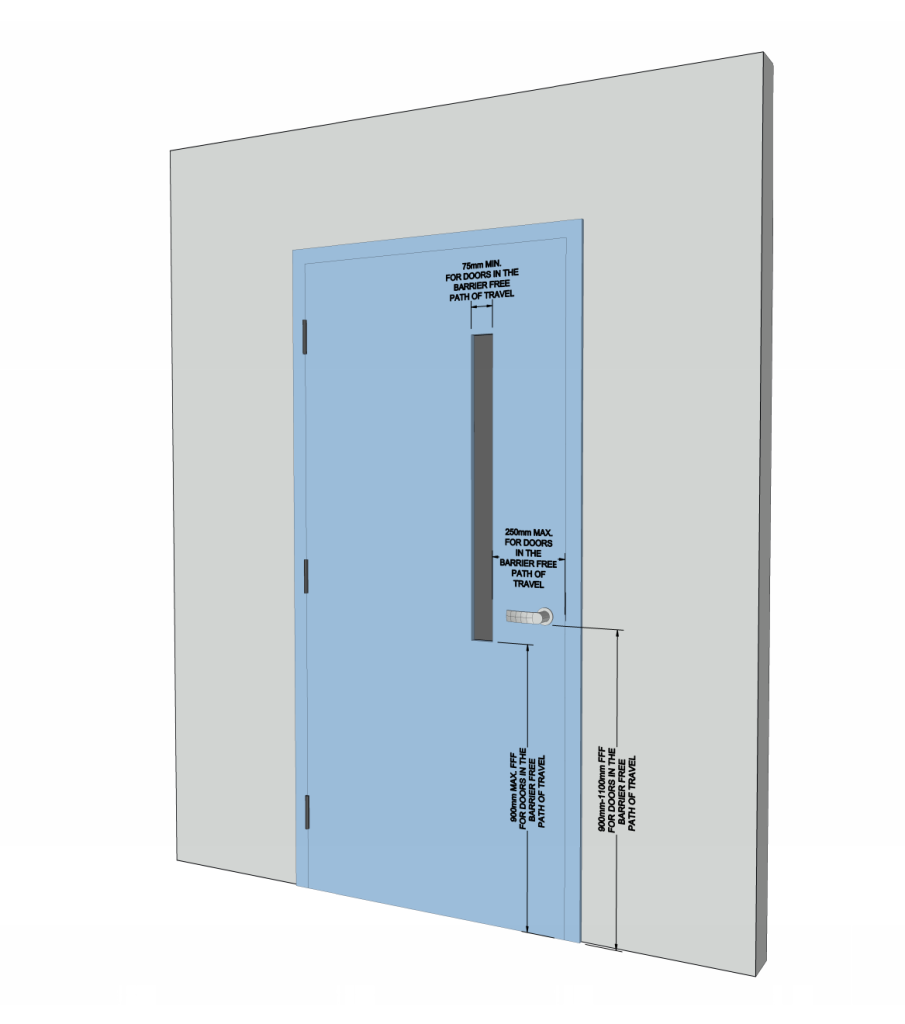Introduction
The Ontario Building Code (OBC) has a number of requirements for doors and hardware that are designed to promote barrier-free accessibility.
Automatic door operators are usually the first things that come to mind, but there are many other details to consider when it comes to ensuring doors meet the barrier-free codes.
Here is our list of the top 5 requirements for barrier-free doors.
This information is adapted from OBC [2012 Building Code (O. Reg 332/12) / O. Reg. 867/21] Section A-3.8.3.3 – Doorways and Doors.
Disclaimer: This list summarizes basic information and is meant only as a partial introduction to the topic of barrier-free code compliance requirements. Please refer directly to the OBC and/or other applicable codes and standards before making any design decisions. Specific conditions, exceptions and interpretations can create unique applications that are not covered in this article.
If you have questions about a particular application, reach out to our consulting team here.
1. Clear Door Opening Width
There can be a big difference between the width of a door and the opening’s actual clear opening width (COW). Frame stops, perimeter seals, hinges, and the thickness of the door are just some of the factors that can reduce the clear opening, which can easily be 100mm (approx. 4”) less than the width of the door panel.
The OBC states that every doorway in a barrier-free path of travel must have a clear opening of at least 860mm when the door is in the open position. Research shows this dimension allows passage for the vast majority wheeled mobility devices.
In recent years, the typical width of a single swing door has grown from 915mm (approx. 36”) to 965mm (approx. 38”) to allow for the 860mm minimum clear opening requirement when the door is in the open to 90 degrees.
Widths of glass, pivot and specialty doors must to be reviewed with their specific hardware to ensure the clear opening requirement is met.
The code also notes specific restrictions on projections into the clear opening, such as those from door- or frame-mounted hardware:
- There can be no projection into the COW between the finished floor and a height of 865mm.
- Between 865mm and 2030mm above the finished floor, projections into the COW may not exceed 100mm.
[OBC reference: A-3.8.3.3.(1)]
2. Mounting Heights for Opening Devices
Opening devices that are the only means of operation for barrier-free doors must be mounted between 900mm and 1100mm above the finished floor.
Opening devices can include lever sets, exit devices, controls for automatic operators, or any other opening hardware device.
[OBC reference: A-3.8.3.3.(3)(b)]
3. Clearances Around Doorways
Doors in a barrier-free path of travel that do not have an automatic operator require particular clearance between the edge of the door and adjacent walls or obstructions. This ensures there is enough space to maneuver a mobility device when operating the door.
Note: if the minimum clearances cannot be met, an automatic door operator is required.
The clearance requirement varies depending on the direction in which the door swings.
- When the door swings toward the person approaching it, 600mm of clear space is required on the latch side of the door.
- When the door swings away from the approach, the clearance requirement on the latch side is 300mm.
- A sliding door requires 300mm clearance on the latch side of the opening.
In all cases, this clear space must extend for the entire height of the doorway.
[OBC references: A-3.8.3.3.(11)(b)]
4. Door Operator Requirements and Push Button Locations
There are three main locations where power door operators are required:
- For most occupancy groups, every door that provides a barrier-free path of travel through a barrier-free entrance requires an automatic door operator.
- Door operators are required on barrier-free public-use washrooms.
- As noted above, openings where clearance requirements cannot be met require door operators.
The OBC also details requirements for the size, mounting height and mounting location of operator controls, like push buttons and wave sensors.
- Face dimension: At least 150mm in diameter if round, or at least 50mm by 100mm if rectangular.
- Mounting height: Centred between 900mm and 1100mm above the finished floor (AFF). Vertical wall-mounted or free-standing controls must be mounted no more than 200mm AFF and extend to no less than 900mm AFF.
- Location: Between 600mm and 1500mm beyond the leading edge of the door swing on the pull side. There is no specified minimum distance for the push side.
In addition to these requirements, the OBC specifies that controls must:
- be located on both sides of the door in a clearly visible location
- not obstruct the path of travel
- be operable by a closed fist
- incorporate the International Symbol of Access.
[OBC references: Operator location requirements – A-3.8.3.3.(4); ADO Button locations and mounting – A-3.8.3.3.(17)]
5. Vision Panels
Vision panels (often called glass lites) help users see whether there is a person or obstruction on the other side of a door before operating the opening. There are other advantages as well.
The OBC does not require vision panels on doors in a barrier-free path of travel, however, if a lite is added, the OBC specifies that it must be:
- At least 75mm wide.
- Located so the bottom of the light is not more than 900mm above the finished floor.
- Located with the edge not more than 250mm from the latch side of the door.
[OBC reference: A-3.8.3.3.(14)]
Final Note
This list introduces several Ontario Building Code requirements for barrier-free door openings, but it is not exhaustive.
There are many other details included in the OBC that can affect door design, including restrictions for door closer speed and opening force requirements, applications specific to dwelling units and other conditions.
Our consulting team is always available to answer your questions or provide guidance on specific barrier-free door applications, or with any other door, frame or hardware queries.







